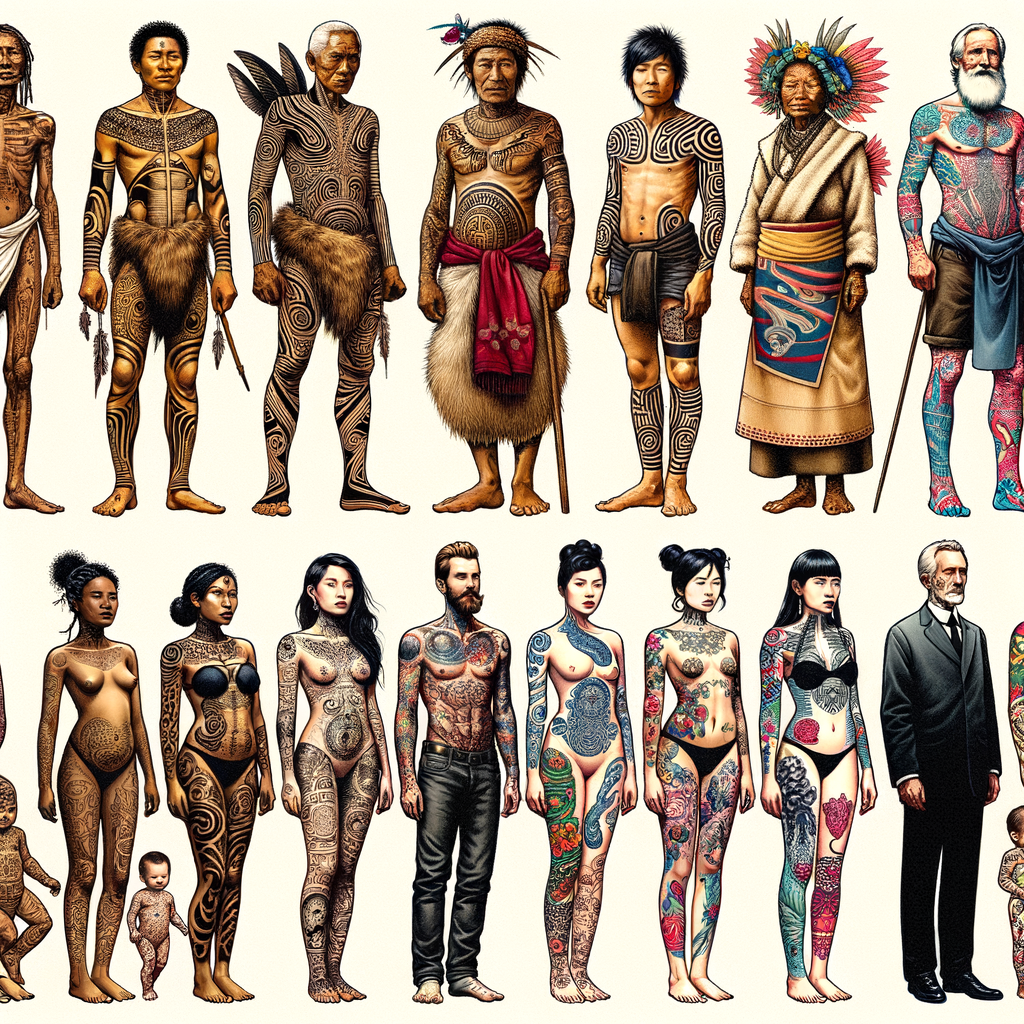
Introduction to Tattoo Art History
Have you ever wondered about the history of tattoos? Tattoos are not just a modern trend, they have a long and fascinating history. In this blog post, we will explore the definition of a tattoo and provide an overview of the history of tattooing.
- Definition of Tattoo
- Overview of the History of Tattooing
A tattoo is a form of body art. It’s created by inserting ink, dyes, or pigments, either temporary or indelible, into the dermis layer of the skin to change its pigment or color. Tattoos can be simple or intricate, small or large, and can be placed almost anywhere on the body. They can be used to express personal beliefs, commemorate loved ones, or simply as a form of self-expression.
The history of tattooing is as colorful as the tattoos themselves. It’s believed that the practice of tattooing has been around for thousands of years, with the oldest known tattoo dating back to between 3370 BC and 3100 BC on the body of a man known as the Iceman.
Throughout history, tattoos have served various purposes. In ancient times, they were used for spiritual or ceremonial rites, as a form of punishment, or to mark status and rank. In some cultures, tattoos were believed to provide protection or healing powers.
In the modern era, tattoos have evolved into a popular form of self-expression and artistry. They are no longer limited to certain groups or classes but are embraced by people from all walks of life.
Stay tuned as we delve deeper into the ancient origins of tattoos, their evolution over time, the different tattooing techniques used throughout history, and the role of tattoos in different cultures. We’ll wrap up with a look at the continuing legacy of tattoos in today’s society.
Ancient Tattoos: The Dawn of Tattooing
As we delve into the fascinating world of tattoo history, we journey back to ancient times when tattoos were more than just body art. They were symbols of identity, status, and beliefs. Let’s explore the earliest known tattoos and their significance in ancient cultures.
Tattoos in Ancient Times
Understanding the history of tattoos requires us to travel back in time, to a period when every mark told a story. Let’s explore this captivating journey.
- Earliest known tattoos
- Significance of tattoos in ancient cultures
The earliest known tattoos date back to between 3370 BC and 3100 BC. They were discovered on the body of a man known as ‘Ötzi the Iceman’, found in the Alps. Ötzi had 61 tattoos, which were made by making small incisions in the skin and rubbing in charcoal. These tattoos were not just for decoration. Scientists believe they may have been used as a form of early acupuncture to relieve pain.
In ancient cultures, tattoos held profound significance. In Ancient Egypt, for instance, tattoos were predominantly found on women, suggesting a link to fertility and rejuvenation. The ancient Greeks and Romans used tattoos to mark criminals and slaves. In Polynesian culture, tattoos were deeply integrated into society, symbolizing a person’s status, bravery, and spiritual beliefs.
Thus, tattoos in ancient times were not merely body art. They were a language in themselves, speaking volumes about the wearer’s identity, status, and beliefs. As we continue to explore the history of tattoos, we’ll see how this form of self-expression has evolved and adapted to different cultures and eras.
Evolution of Tattoos: From Tradition to Trend
As we delve into the fascinating world of tattoos, it’s important to understand how this art form has evolved over time. Let’s start by exploring traditional tattooing, its methods, materials, symbolism, and significance.
Traditional Tattooing
Traditional tattooing has a rich history, with techniques and symbolism that have been passed down through generations. Let’s explore the methods and materials used in traditional tattooing, as well as the symbolism and significance of these tattoos.
- Methods and materials used in traditional tattooing
- Symbolism and significance of traditional tattoos
Traditional tattooing methods varied greatly across different cultures. However, most involved the use of sharp objects like bone, wood, or metal to puncture the skin. The ink was often made from soot or other natural materials. For instance, the Maori people of New Zealand used a chisel made of bone to carve designs into the skin, while the Inuit people used a needle and thread soaked in soot.
Traditional tattoos were more than just body art. They often held deep cultural significance and were used to signify a person’s status, achievements, or spiritual beliefs. For example, in many Pacific Island cultures, tattoos were a rite of passage, marking the transition from childhood to adulthood. In Native American cultures, tattoos often represented a person’s clan or spiritual guide.
In conclusion, traditional tattooing was a deeply ingrained part of many cultures, with unique methods and materials used for tattooing and significant symbolism attached to the tattoos. As we continue our journey through the history of tattoos, we’ll see how these traditions have evolved and influenced modern tattoo trends.
Tattoo Culture History
As we delve into the evolution of tattoos, it’s important to understand the significant changes in the way society perceives tattoos and their role in modern culture.
- Shift in Societal Perception of Tattoos
- Role of Tattoos in Modern Culture
Historically, tattoos were often associated with rebellion, deviance, or non-conformity. However, in recent years, this perception has dramatically shifted. Tattoos are now seen as a form of self-expression, a way to commemorate personal experiences, or even a fashion statement. According to a Pew Research Center study, nearly 40% of millennials have at least one tattoo, indicating a significant shift in societal acceptance.
In modern culture, tattoos have become a popular form of self-expression and individuality. They are often used to represent personal beliefs, values, or interests. For example, a person might get a tattoo of a musical note to express their passion for music. In addition, tattoos have become a common sight in various professional fields, breaking the stereotype that they are only for outcasts or rebels. From athletes to CEOs, many people proudly display their ink.
In conclusion, the history of tattoo culture has seen a significant shift in societal perception and an increased role in modern culture. Tattoos have evolved from being a mark of rebellion to a widely accepted form of self-expression and individuality.
Tattooing Techniques History
In the vast world of tattooing, the techniques used have evolved significantly over time. Let’s delve into the fascinating history of tattoo designs and how historical events have shaped them.
Historical Tattoo Designs
Historical tattoo designs are like a window to the past, revealing intriguing insights about different cultures and eras. They have undergone a significant evolution, influenced by various historical events.
- Evolution of Tattoo Designs
- Impact of Historical Events on Tattoo Designs
The evolution of tattoo designs is a captivating journey. In ancient times, tattoos were primarily used for spiritual and protective purposes. They were simple in design, often consisting of dots, lines, and other basic shapes. As civilizations advanced, so did the complexity and variety of tattoo designs. In the Middle Ages, tattoos were often associated with sailors and explorers, featuring nautical themes. By the 20th century, tattoos had become a form of personal expression, with designs ranging from portraits to abstract art.
Historical events have had a profound impact on tattoo designs. For instance, during World War II, many soldiers got tattoos as a symbol of pride and camaraderie. These designs often included military insignia, patriotic symbols, and reminders of home. Similarly, the cultural revolution of the 1960s and 70s saw an explosion of countercultural tattoo designs, reflecting the era’s spirit of rebellion and freedom. Today, tattoo designs continue to be influenced by social, political, and cultural events, making them a living testament to our collective history.
Modern Tattoo Techniques
As we delve into the present era, let’s explore the modern techniques that have revolutionized the art of tattooing. These techniques have not only made the process easier but also more precise and diverse.
- Introduction of Electric Tattoo Machines
The introduction of electric tattoo machines has been a game-changer in the world of tattoos. These machines, invented in the late 19th century, have made tattooing faster, more accurate, and less painful. They use electromagnetic coils to move the needle up and down, injecting the ink into the skin.
Electric tattoo machines have two types: coil and rotary. Coil machines use an electromagnetic current to drive the needle, while rotary machines use a motor. Both types have their own advantages. Coil machines are known for their precision, making them ideal for detailed work. On the other hand, rotary machines are quieter and cause less skin damage, making them suitable for longer sessions.
- Current Trends in Tattoo Techniques
Nowadays, tattoo artists are pushing the boundaries of what’s possible with ink and skin. Let’s look at some of the current trends in tattoo techniques:
- Watercolor Tattoos: These tattoos mimic the look of watercolor paintings with their vibrant colors and soft, undefined edges.
- Dotwork: This technique uses tiny dots to create intricate patterns and images. It’s often used in geometric and mandala tattoos.
- Blackwork: This style uses bold, black ink to create striking designs. It’s often used for tribal tattoos and silhouettes.
- Realism: As the name suggests, this technique aims to create tattoos that look as realistic as possible, often resembling photographs.
These are just a few examples of the many innovative techniques being used in the tattoo industry today. As artists continue to experiment and push the boundaries, we can expect to see even more exciting developments in the future.
Tattooing in Different Cultures
In this section, we will explore the rich history and significance of tattoos in different cultures, focusing particularly on Asian tattoo culture.
Asian Tattoo Culture
Asia, with its diverse cultures and traditions, has a long and fascinating history of tattooing. Let’s delve into the history and significance of tattoos in Asian cultures and explore some popular Asian tattoo styles and their meanings.
-
History and Significance of Tattoos in Asian Cultures
Tattooing has been a part of Asian cultures for thousands of years. In ancient times, tattoos were often used as symbols of status, bravery, and spiritual protection. For instance, in Japan, tattoos were initially used on clay figures for spiritual purposes. Later, they became associated with the Yakuza, the Japanese mafia, leading to a complex perception of tattoos in Japanese society.
In other parts of Asia like China and the Philippines, tattoos were used as marks of achievement and courage. Despite the varied uses and meanings, one thing remains constant: the deep-rooted significance of tattoos in these cultures.
-
Popular Asian Tattoo Styles and Their Meanings
Asian tattoo styles are as diverse as the cultures they originate from. Here are a few popular ones:
Tattoo Style Origin Meaning Irezumi Japan Traditionally associated with the Yakuza, these intricate, full-body designs often feature mythological creatures and nature themes. Sak Yant Thailand These geometric designs, often tattooed by Buddhist monks, are believed to provide protection and good luck. Peony China Symbolizing wealth, honor, and high social status, peony tattoos are often used in larger, intricate designs. These are just a few examples of the rich and diverse world of Asian tattoo styles. Each design carries a unique story and meaning, reflecting the rich cultural heritage of Asia.
Western Tattoo Culture
When it comes to the art of tattooing, the Western world has a rich and dynamic history. This section will explore the evolution of tattoo culture in the West and the impact of celebrity culture on tattoo trends.
-
Evolution of Tattoo Culture in the West
The art of tattooing has been a part of Western culture for centuries, but it has evolved significantly over time. In the past, tattoos were often associated with sailors, soldiers, and outlaws. However, in the 20th century, tattoos began to gain mainstream acceptance and popularity.
One of the key turning points was the 1960s, when the counterculture movement embraced tattoos as a form of self-expression and rebellion. From there, tattoos became increasingly popular among all segments of society. Today, tattoos are seen as a form of personal expression and art, with a wide range of styles and designs available.
Century Tattoo Perception 19th Century Associated with sailors, soldiers, and outlaws 20th Century Accepted as a form of self-expression and rebellion 21st Century Seen as a form of personal expression and art -
Impact of Celebrity Culture on Tattoo Trends
Celebrity culture has had a significant impact on tattoo trends in the West. When a celebrity gets a new tattoo, it often becomes a trend among their fans and the general public. For example, after singer Rihanna got a Maori-inspired hand tattoo, there was a surge in interest in this style of tattooing.
Similarly, celebrities like David Beckham and Angelina Jolie, known for their extensive tattoo collections, have helped to normalize and popularize tattoos in the mainstream culture. Their influence has led to a greater acceptance of tattoos in society and has inspired many people to get their own.
However, it’s important to remember that while celebrities can influence trends, each person’s choice to get a tattoo is a personal decision. Tattoos are a form of self-expression, and the best tattoo for you is one that reflects your individuality and personal style.
Conclusion: The Continuing Legacy of Tattoos
As we have journeyed through the fascinating history of tattoos, we have seen how this art form has evolved from ancient traditions to modern trends. Now, let’s take a look at the current state of tattoo art and what the future holds for this enduring form of self-expression.
- Current state of tattoo art
- Future trends in tattooing
Tattoo art has come a long way from its ancient roots. Today, it is a widely accepted form of art and self-expression. The stigma once associated with tattoos has largely faded, replaced by an appreciation for the skill and creativity involved in creating these permanent works of art. Tattoo artists are now recognized as true artists, often specializing in specific styles such as traditional, realism, tribal, or watercolor.
Moreover, the rise of social media has allowed tattoo artists to showcase their work to a global audience, further elevating the status of tattoo art. According to a 2019 survey, nearly 30% of Americans have at least one tattoo, demonstrating the widespread acceptance of this art form.
As for the future, the world of tattooing continues to evolve and innovate. One emerging trend is the use of technology in tattoo design. Digital tools are being used to create more precise and intricate designs, and even to offer ‘virtual tattoos’ that can be tried on before making the commitment to a permanent tattoo.
Another trend to watch is the rise of ‘tattoo therapy’. This involves using tattoos as a form of healing and recovery, particularly for people who have experienced trauma or illness. For example, many breast cancer survivors are now choosing to have beautiful tattoo designs instead of traditional nipple reconstruction after mastectomy.
With these exciting developments, it’s clear that the legacy of tattoos will continue to thrive and inspire for many years to come.
In conclusion, tattoos have a rich and varied history that spans cultures and continents. From ancient traditions to modern trends, this art form continues to evolve, reflecting the changing times and the endless creativity of the human spirit. As we look to the future, one thing is certain: the legacy of tattoos is far from over.






